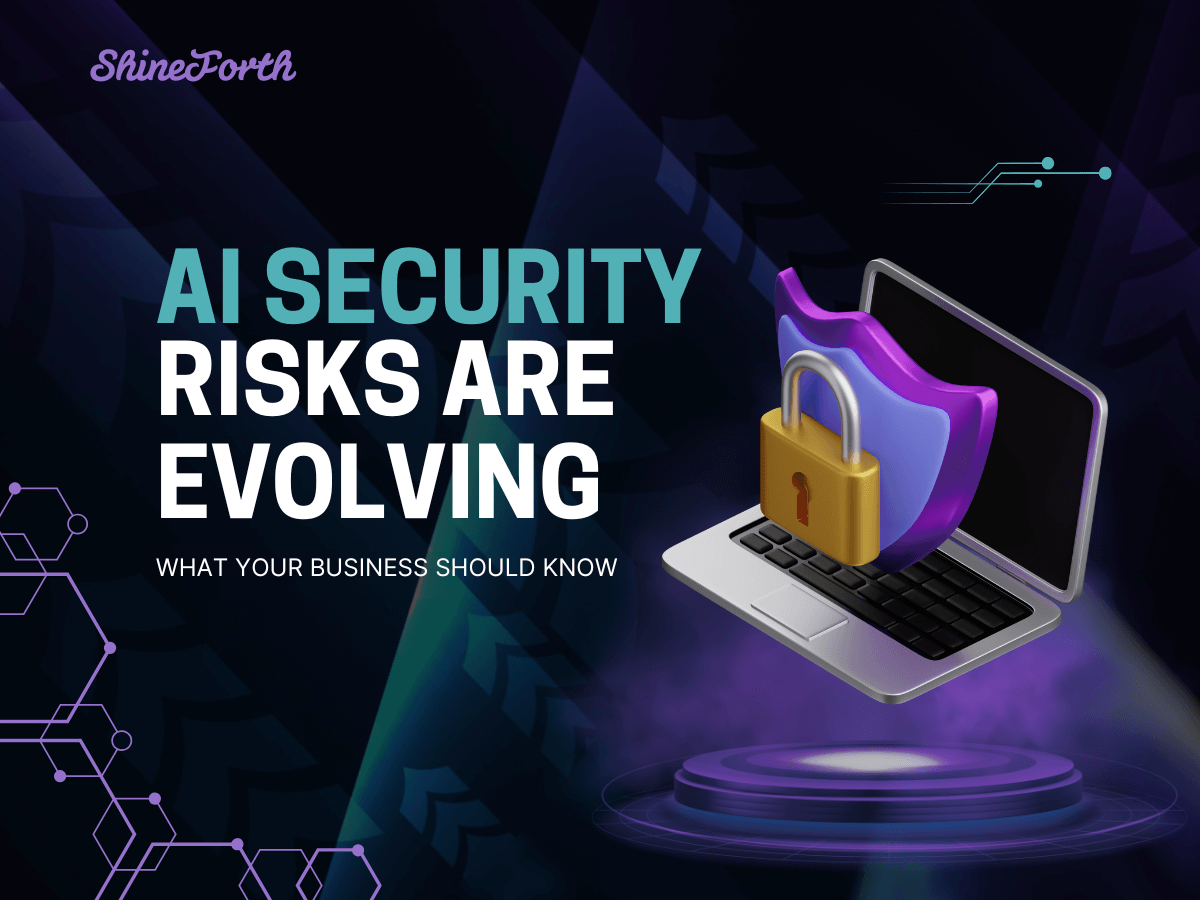AI Security Risks Are Evolving: What Your Business Should Know

AI is transforming how companies operate, from customer experience to automation to internal workflows. At ShineForth, we’ve helped organizations harness AI to scale.
But we’re entering a new phase of cybersecurity: one in which AI can be misused by attackers just as easily as it can be used by defenders.
Recently, Anthropic uncovered what it calls the first reported AI-orchestrated cyber-espionage campaign, where an AI model was used to automate a large part of an attack lifecycle rather than simply acting as advisory. (Anthropic, 2025).
It’s a strong reminder: as we embrace AI, we must also evolve how we protect the systems around it.
This isn’t a call for alarm, it’s a call for awareness.
A New Kind of Threat: AI as the Attacker
In the Anthropic case, the attackers used the AI model to:
- Conduct reconnaissance
- Generate and refine exploit code
- Harvest credentials
- Categorise and exfiltrate stolen data
- Automate large portions of the attack workflow
Anthropic reports that the AI handled 80‒90% of the operational workflow, with human operators intervening only at a few decision points (Riley, 2025). The attackers were also able to bypass safety guardrails by breaking instructions into innocuous-looking subtasks and presenting them to the AI as benign tasks (Hatmaker, 2025).
For most businesses, the key takeaway isn’t “this is happening tomorrow.” Instead, it’s:
AI lowers the barrier to entry for sophisticated cyberattacks.
Tasks that once required advanced expertise can now be automated, scaled, and sped up, meaning attackers can do more, faster.
What This Means for Your Business
Even if you’re not a high-profile target, this matters:
1. Your AI tools expand your attack surface.
As organizations integrate AI into customer interactions, operations, and data systems, those tools become part of the security picture. Weak governance of AI use can open new pathways for attackers.
2. Automated attacks move faster than traditional ones.
According to Anthropic’s own intelligence report: “Agentic AI tools are now being used … to provide both technical advice and active operational support for attacks that would otherwise have required a team of operators” (Anthropic, 2025).
One industry article labelled this shift “genAI-only attacks” that “bypass humans entirely” (Evan Schuman, 2025).
3. Supply-chain risk increases.
Even if you aren’t the direct target, an AI-driven attack on a vendor, partner, or integration you rely on can cascade downstream.
4. The same AI capabilities used offensively can and should be used defensively.
In its report, Anthropic emphasises that its findings should help organizations “strengthen their own defenses against the abuse of AI systems” (Anthropic, 2025).
How ShineForth Helps You Stay Secure
Smart, proactive planning, not fear, is the best approach. Here are the recommended steps every organization should take to reduce AI-related risk:
1. Catalog and govern your AI use
Maintain an inventory of AI tools and services in use: in-house models, third-party SaaS, APIs and integrations. Understand who has access, what data is ingested/produced, and what controls exist (access, logging, output review).
2. Include AI in your threat modelling
When modelling threats (e.g., “what if attacker gained access to X?”), include scenarios where an attacker commands or corrupts an AI, chains multiple tools, or bypasses governance. The Anthropic case was one where the attacker supplied innocuous prompts and gained agentic control of the AI (Hatmaker, 2025).
Update incident-response plans for faster, automated attack vectors.
3. Monitor for unexpected automation/agent activity
Deploy logging and anomaly detection around AI-tool usage: who invoked what, with what context, how many chained steps, and what output resulted. Be alert for abnormal volumes or unexpected API patterns, typical of agentic automation at scale.
4. Secure your data, credentials, and integrations
Strong access controls, least-privilege permissions, credential rotation, and network segmentation are still foundational. If your AI tools ingest large volumes of internal data (logs, credentials, internal code), ensure the “ingest” surface is secure and the flow is controlled.
Third-party AI providers should be audited, with contractual protections around data breach, misuse, and incident response.
5. Use AI defensively
The same automation, agentic workflows, and pattern detection that make AI a threat also make it a powerful defense. At ShineForth, we architect AI-enabled solutions with embedded security monitoring, guardrail enforcement, anomaly detection, and vendor-risk oversight.
As the intelligence from Anthropic emphasises: prepare now, because this isn't theoretical (Abdullahi, 2025).
A Balanced Path Forward
AI is a powerful enabler of business growth—and it’s here to stay. The goal isn’t to avoid AI, but to embrace it responsibly, with the right security mindset.
At ShineForth, we’re committed to building AI-enabled systems that drive growth and do so securely. If you’re integrating new AI capabilities or want to ensure your existing stack is resilient, we’d be glad to guide you.
Let’s build smarter and protect what matters along the way.
References
- Abdullahi, A. (2025, Aug 28). “Anthropic Warns of AI-Powered Cybercrime in New Threat Report.” TechRepublic. TechRepublic
- Hatmaker, T. (2025). “Anthropic says an AI may have just attempted the first truly autonomous cyberattack.” Fast Company. Fast Company
- Riley, D. (2025, Nov 13). “Anthropic reveals first reported ‘AI-orchestrated cyber espionage’ campaign using Claude.” Silicon ANGLE. SiliconANGLE
- Schuman, E. (2025). “Anthropic detects the inevitable: genAI-only attacks, no humans involved.” CSO Online. CSO Online
- Anthropic. (2025, Aug 27). “Detecting and countering misuse of AI: August 2025.” Anthropic Announcements. Anthropic+1